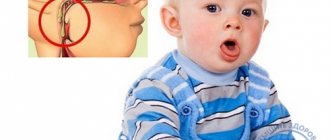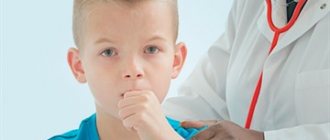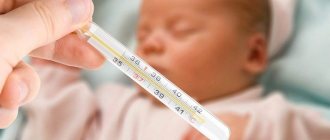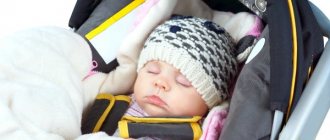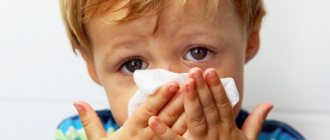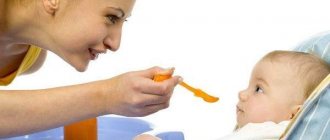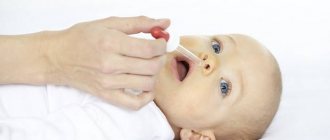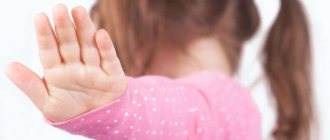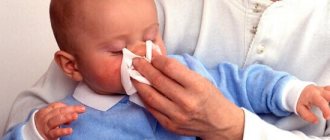Causes of the disease
During viral infections, the temperature rises in children and adults. This is a protective reaction of the body; thanks to a sharp jump, many microorganisms die. A child’s cough and runny nose can occur without a high fever. This happens if the child has a weakened immune system or the virus is not too dangerous, and the body does not even turn on the defense mechanism.
A swollen nose, colorless snot and a dry cough are signs of allergic rhinitis. The disease requires treatment; in an advanced state, it can develop into bronchial asthma. With viral infections, the baby is bothered by a wet cough and a severe runny nose, often with milky or greenish snot.
Reasons for the development of pathology
The presence in a child of a cough with a runny nose without fever is a sign of an incipient cold or allergy
The main signs of a cold, which can occur when various viruses enter a child’s body, are a runny nose and cough. The baby’s immune system begins to react to pathogenic microorganisms and enter into a peculiar reaction with them.
However, in some cases, problems arise with recognizing the virus and it easily penetrates into the cells of the body. If a bacterial disease develops, an increase in body temperature is immediately noted, but with a viral infection, the indicators remain normal.
In the absence of effective treatment for viral rhinitis, the risk of developing a severe inflammatory process in the sinuses increases, that is, sinusitis develops.
Parents need to understand that pathogenic microorganisms may enter the throat and trachea area.
In such a situation, in the absence of effective treatment, complications may develop in the form of:
- sore throat
- bronchitis
- tracheitis
- pharyngitis
- pneumonia
The penetration of various viruses into the child’s body significantly disrupts the functioning of the immune system, so the course of such a disease can be supplemented by a bacterial infection. With ARVI, other pathogenic microorganisms present in the child’s body are also activated, which leads to the development of an inflammatory process in the ENT organs.
Parents need to understand that even in the absence of fever with a cough and runny nose, it is imperative to show the child to a specialist who will find out the causes of this condition and prescribe effective treatment.
Useful video - Cough in children: causes, types and treatment
Why does a newborn sneeze, the main reasons and what to do in such a situation?
In some cases, the cause of cough and runny nose without fever may be the development of allergic rhinitis. Most often, this pathology is diagnosed in children and adults who spend a long time in a dusty room. Allergic rhinitis can occur as a reaction to chemicals, pollen, children's cosmetics and animal dander. In some cases, even healthy children may experience a runny nose and cough without fever due to too dry air in the children's room.
If a cough and runny nose without fever bother a child for a long time, this may be a dangerous signal. An allergic reaction can lead to the development of such a complex disease as bronchial asthma. It is for this reason that it is necessary to show the child to the doctor in time, which will avoid the development of many complications.
Drug treatment
It is important to remember that in childhood it is necessary to use various medications only after consultation with a specialist.
To combat a viral infection, antiviral drugs are usually used, since without their help it is unlikely to achieve a positive result.
Features of treatment:
- The following drugs have a good effect in the treatment of viral diseases: Ingavirin, Remantadine, Isoprinosine, Ribavirin, Arbidol.
- Such antiviral drugs can be used in children from the first day of their birth. In order to activate the body's strength to fight the disease during drug therapy, interferonogenesis inducers are prescribed: Laferon, Cycloferon, Viferon, Anaferon.
- A severe cough and nasal congestion cause children a lot of inconvenience and anxiety, so it is necessary to get rid of unpleasant symptoms. To eliminate nasal congestion and restore breathing, experts prescribe the use of the following medications: Tizin, Farmazolin, Nazivin, Galazolin. It is important to remember that such vasoconstrictor drops are allowed to be used for no more than 5 days, otherwise the risk of developing allergic rhinitis increases. If a child is bothered by a wet cough, treatment should be carried out using medications that help dilute mucus and remove it from the respiratory tract.
- The following drugs have a good effect in the fight against wet cough: ACC, Mucaltin, licorice root tincture.
- If a child is bothered by a dry cough, drugs such as Libexin, Pertussin and Tusuprex are usually used to eliminate it.
- In some cases, a child may suffer from a prolonged cough combined with nasal congestion, but without fever. In such a situation, it is recommended to give the child herbal breast milk, however, this must be done after consulting a doctor. The fact is that such a collection has a suppressive effect on cough, which can disrupt the process of sputum discharge and cause the development of an inflammatory process in the lungs.
- Often a cough and runny nose without fever is a manifestation of an allergic reaction against the background of an inflammatory process in the body. In such a situation, to eliminate tissue swelling and relieve an allergic reaction, the following antihistamines are prescribed: Loratadine, Zaditen, Suprastin, Tavegil.
Traditional methods of treatment
The best folk recipes for treating a runny nose and cough in a child
At home, you can treat a child’s runny nose and cough using folk remedies:
- You can use steam inhalation, when the child inhales the emanating steam from boiled potatoes. To do this, you need to thoroughly wash the root vegetable and boil it. After this, you should slightly tilt the child’s face over the emanating steam, covering himself with a towel on top. He must breathe over the steam for 15-20 minutes, and this procedure is preferably carried out for older children.
- If a cold is accompanied by a runny nose, then homemade nasal drops can be used to relieve nasal congestion. For this, it is recommended to use medicinal plants such as aloe and Kalanchoe, as well as garlic and onions.
- If parents decide to prepare drops from Kalanchoe, then it is best to use a young plant no older than 3-5 years. The squeezed juice must be diluted with water in a ratio of 1:10 and a few drops of the prepared product should be dripped into each nasal passage. It is important to remember that during treatment it is not recommended to combine aloe juice with medications such as Sanorin and Naphthyzin, since there is a danger of developing sinusitis.
- Inhalations with a nebulizer based on soda and medicinal herbs give a good effect for a productive cough and runny nose. At the moment of inhalation of the medicinal solution, the mucous membrane is moistened and the muscles of the bronchi are relaxed, which allows sputum to easily exit the respiratory tract.
Other therapies
When treating a child with a cough and runny nose without fever, it is recommended to adhere to the following rules:
- it is necessary to maintain optimal humidity in the children's room and this can be done with regular ventilation
- The air temperature in the room should be maintained no higher than 20 degrees
- It is important to organize the child’s drinking regime
- It is recommended to maintain proper and nutritious nutrition, excluding spicy and hot foods from the diet
- During the day, it is fashionable to rinse the child’s nose more often with saline or saline solution
- It is necessary to fill the child’s diet with vegetables and fruits
It is possible to improve blood circulation in the chest area and speed up the discharge of sputum when coughing with the help of warm compresses. For this purpose, you can use boiled potatoes, honey, flour and vegetable oil. All ingredients are mixed together and the resulting mass is applied to the child’s chest area for several hours. After time, the compress is removed from the chest and the baby is carefully wrapped.
It is important that during illness the child consumes as much fluid as possible.
You can offer your baby rosehip decoctions, compotes, tea with lemons, cranberry or lingonberry juice. Decoctions of medicinal plants such as oregano, coltsfoot, plantain and thyme provide a good effect in the fight against cough without fever.
It is necessary to treat a child only after consultation with a specialist, since self-medication can further aggravate the baby’s condition and cause the development of many complications. If a child has an allergic runny nose and cough, then, first of all, it is necessary to identify the allergen and completely protect the child from it.
Effective remedies for dry cough for children
Physiology of the disease
Coughing is a natural reflex of the body. When mucus collects in the bronchi or trachea, the body needs to get rid of it. The infection enters the nasopharynx, and catarrh of the respiratory tract develops. Then a severe cough and runny nose with a lot of mucus develops. If the baby has a long cough, this indicates an allergic reaction. Sometimes a cough can develop on its own, without a runny nose.
Rhinitis is a quick way of self-defense that helps the body clear the nasal cavity of microorganisms. Along with snot (mucus and pus), viruses and bacteria come out of the nose. Rhinitis often begins after severe hypothermia or as a result of the influence of external irritants.
Snot and cough in a baby without fever are a sign of worms
Parasites enter a child's body through dirty household items and unwashed food. Other carriers are pets who lick children and spend a lot of time with them. Bronchial spasm in a child without fever may be an indicator of pinworm infection.
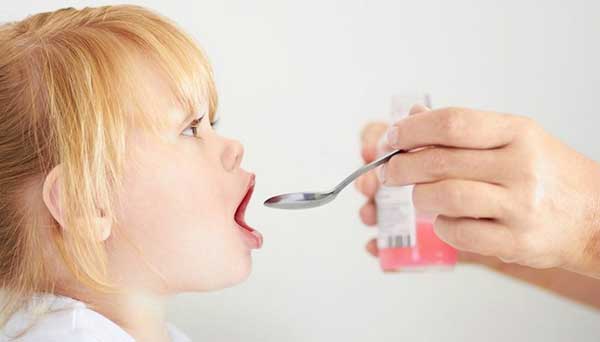
When they enter the body, the parasites begin to actively multiply. Their waste products poison humans. Their toxic effect always affects the child’s immunity.
Parents should understand that many parasites enter the blood and begin to wander throughout the organs. In this case, the first signal of infection is a cough without fever and runny nose.
On this topic:
How to help your child relieve cough at night
In this case, it is possible to cure snot in a baby without fever only with special medications. It is important to follow the dosage of the medicine so as not to harm the young body. If no measures are taken, then a runny nose and an allergic rash occur against the background of a decrease in the body’s immune defense.
Doctors prescribe medications taking into account the young patient’s age, weight and the presence of chronic diseases. Help for a child should be provided only after consultation with a doctor, otherwise harm may occur.
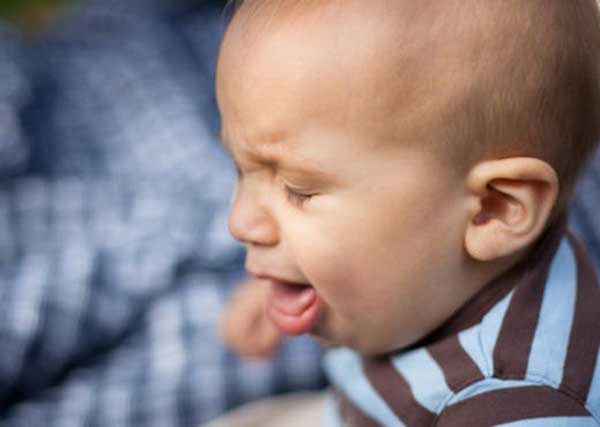
Drug treatment
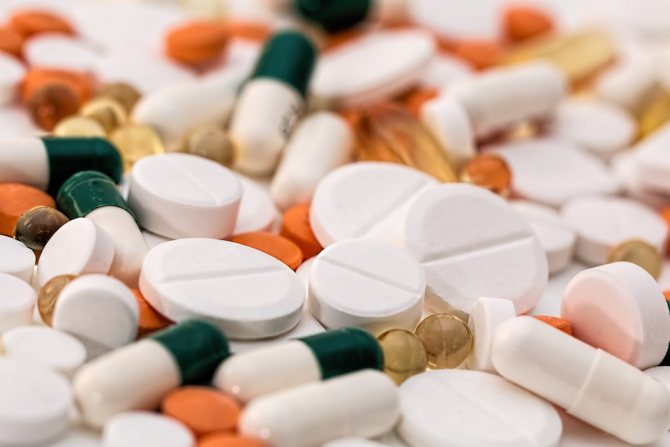
When a cough and runny nose without fever appear, doctors find out the cause of the disease, after which they prescribe a treatment regimen. This may include:
- Antiviral drugs are drugs that kill microorganisms. These are: “Orvirem”, “Tsitovir”, “Rimantadine”, “Ingavirin”. Suitable for infants: “Viferon”, “Anaferon”, “Laferon”. Medicines can be in the form of syrups or suppositories for rectal use.
- Antihistamines are necessary in the treatment of allergies. They are often prescribed in conjunction with other medications for the treatment of colds. Among them: Zodak, Zyrtec.
- Nasal drops or sprays. The safest among them are considered to be preparations based on sea water. “Aqua Maris”, “Aqua Maris +” - effectively help in the treatment of a runny nose without fever.
- Cough medications come in two groups: antitussives or expectorants.
Features of treating cough without runny nose and fever
Treatment of the disease
If the allergic nature of the cough is confirmed, the specialist will prescribe appropriate treatment, which may include:
- Conducting a special test to identify the sensitivity of the baby’s body to a certain group of allergens, and subsequently prescribing antihistamines.
- Creating a special environment in the house that will help prevent any contact of the child with allergens.
- The treatment is carried out comprehensively, so special emphasis is placed on increasing the immunity of the child’s body with the help of general strengthening agents.
- If a cough appears as a reaction to a stressful state of the body, treatment may involve sessions with a child psychotherapist followed by the prescription of sedatives in accordance with the child’s age.
- Despite the absence of a runny nose and fever, a cough can still be a sign of a cold or infectious disease.
After determining the cause of this condition of the body and confirming the diagnosis, the child is treated with medications, which may include:
- Analgesics
- Antispasmodics
- Immuno-strengthening
- Anti-inflammatory
- Antiviral drugs
A good effect is obtained by supplementing the main treatment with physiotherapeutic procedures such as inhalations and warming.
An unpleasant and dangerous phenomenon is the entry of a foreign body into a child’s respiratory system, a clear sign of which is a strong cough without any additional symptoms.
In this case, emergency treatment and sometimes surgery will be required. Despite the small size of a foreign object, its entry into the trachea and bronchi can cause damage to the tissues of the respiratory system, which is why emergency assistance to the baby is required in this situation.
More information about children's cough can be found in the video.
How to cure an allergic cough - effective drug treatment and the best folk advice
Parents may be frightened by a cough that develops as a result of food debris getting stuck in the throat, but in this case it is quite possible to cope on their own.
For this it is recommended:
- Give your baby warm water.
- Ask your child to gargle with a soda solution.
- If the child is small, it is necessary to ensure that he is in an upright position and gargle with a syringe.
- Provoke the appearance of a gag reflex.
If you are able to help your child using the methods listed above, you must consult a doctor. This need is caused by the fact that pieces of food remaining in the throat may begin to decompose, and this, in turn, can provoke an inflammatory process with swelling of the surrounding tissues.
It is important to remember that any treatment of a child should be carried out only after visiting a pediatrician and any amateur activities should be completely excluded. If a cough appears without a runny nose or fever, it is necessary to identify the cause of the child’s condition, and only an experienced specialist can do this. Self-treatment of a child’s cough may not only not alleviate the condition, but may even worsen the situation.
What remedies are used for a runny nose?
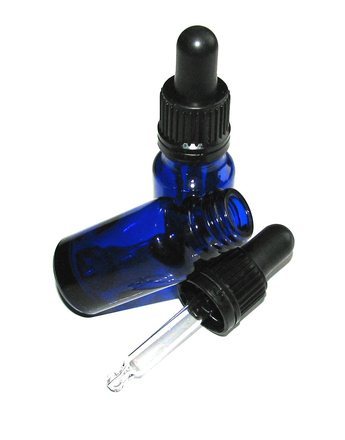
For intranasal use, drops or sprays are used. The drug, duration and dosage are prescribed only by the attending physician. Treatment for a runny nose depends on what microorganisms are causing it. So, in the case of a viral infection, antiviral drugs are used, but antimicrobial drugs will not bring any results.
A runny nose without fever in a child is treated with the following groups of medications:
- Vasoconstrictors - today the relevance of using these drugs for the treatment of runny nose in children and adults is questionable. Many doctors agree that you should not use such drops. Others allow use, but not longer than 5 days, otherwise allergic rhinitis may occur. Vasoconstrictor medications help within a few minutes and relieve nasal congestion and swelling. But they worsen the patency of blood vessels. Among them: Tizin, Vibrocil, Nazivin.
- Antibacterial agents - suppress the activity of microbes, relieve inflammation, fight pus. These include: “Isofra”, “Dioxidin 0.5%”;
- Antiviral drugs are aimed at destroying viruses. Among them: “Nazoferon”, “Grippferon”.
Doctors also prescribe moisturizing drops (“Salin” or “Physiomer”), they relieve swelling and speed up recovery. Sometimes it is advisable to use homeopathic medicines that prevent relapses.
Attention! Treatment of rhinitis in infants is carried out under the supervision of a pediatrician. Only a few types of drops are suitable for a newborn.
What is a physiological runny nose
Cough and runny nose without fever in infants in 85% of cases turns out to be the cause of physiology. The gradual adjustment of all body systems also applies to the mucous membranes. Excessive discharge from the nasal cavity, regular discharge of sputum is an indicator of immature functioning of the organs.
The baby spends most of his time in a horizontal position, because of this, mucus flows down the nasopharynx, provoking bronchospasm. In this case, a cough from snot in a baby is considered normal.
During this period of time, the baby should be given a lot of time. Transparent discharge from their nose and mouth should be removed with cotton pads. During the night's rest, it is necessary to regularly turn the baby onto its side so that phlegm does not cause an attack of suffocation.
How to treat a cough?
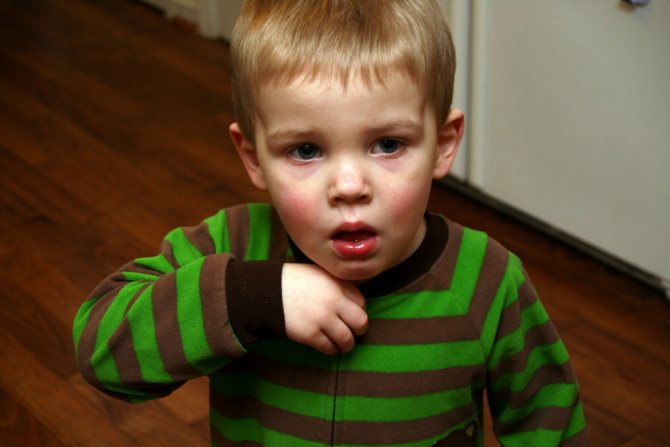
There are two types of cough - dry and wet. The first can form due to an irritated throat or if sputum from the trachea and bronchi is not separated. In the second case, the cough is productive and expectorant. Sputum moves away from the walls of the bronchi, speeding up recovery.
Pediatricians prescribe two types of cough suppressants. They are produced in the form of syrups, lozenges, and lollipops. Syrups are suitable for children, and adult children can use lozenges.
- Antitussive drugs are aimed at eliminating cough if it is unproductive. The components in these medications reduce the sensitivity of receptors in the pharynx and certain areas of the cerebral cortex. This helps relieve cough. The drugs include: “Sinekod”, “Omnitus”, “Libexin”.
- Expectorants – help thin mucus in the bronchi. These include “Ascoril”, “Bromhexine”, “Ambrobene”.
Expectorant drugs are prescribed to children over two years of age; younger children cannot yet expectorate mucus properly.
A barking cough in a child without fever indicates that sputum is not being expectorated well. Attacks worsen at night and may indicate asthma, viral infections, bronchitis, pneumonia or inflammation of the larynx.
Causes of rhinitis and how to treat a runny nose
A child’s temperature without cough and snot is not a good indicator. It is better to make an appointment at the clinic. With a runny nose, everything is much simpler; you just need to put drops in your nasal passages to clear them of mucus and make breathing easier.
What will the pediatrician prescribe if a child has symptoms of high fever and snot? The recipe will definitely contain an antipyretic agent and drops:
- Salin is prescribed when a baby has a runny nose with fever. This is an antiviral spray, the active ingredient is sodium chloride;
- Nazoferon - a spray is prescribed when a small patient has green snot and cough. The drug has antiviral and antibacterial effects;
- Isofra is a safe spray that can be used to treat young children. Cough, snot, temperature 38 degrees Celsius - these are the main symptoms when a pediatrician can prescribe this medication;
- Delufen is an antiviral drug that also has antiallergic properties. Effective when the patient has a cold.
A runny nose in a baby (rhinitis) may appear due to a weakened immune system or too cold air outside. In this case, snot and cough may occur.
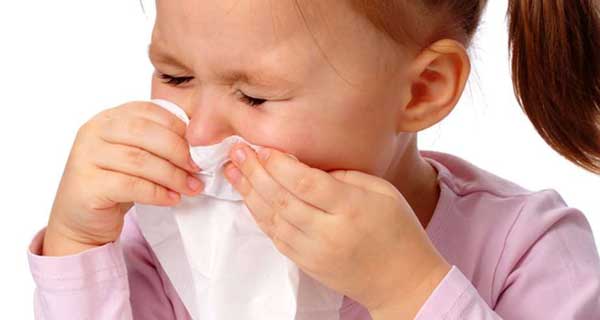
You cannot use drops for a runny nose constantly. The choice of medication is made on an individual basis. If the baby has mild congestion, the pediatrician may prescribe medications based on natural ingredients. Vasoconstrictor sprays are prescribed when a child has a cough, snot and fever.
What to do if you have allergies?
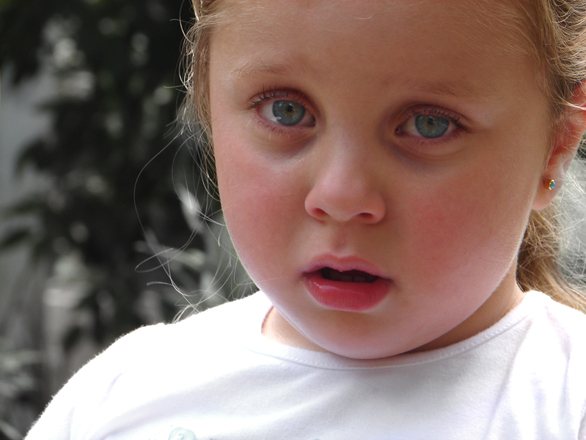
Parents will have to determine the main allergen and eliminate its influence on the child. The irritant can be a food product, a household cleaning product (for example: floor cleaning liquid), animal hair, etc.
At the second stage, the child should take a course of antihistamines: Zodac or Zyrtec. They are usually taken overnight, for 5 to 10 days. But the duration of treatment is determined by the attending physician.
If the main allergen cannot be identified, then it is worth taking a special blood test. This test will determine the main irritants of the child’s body.
Causes of snot and cough
In infants, snot and cough are constant companions of acute respiratory infections. They develop against the background of the penetration of various viruses into the body. Agents penetrate the cell and multiply by absorbing its resources. Most often, bacteria begin to actively behave in the tract of babies.
It is not always necessary to treat coughs in young children. In some cases, this pathology is temporary and goes away on its own.
With rhinitis, a baby experiences severe inflammation of the nasal mucosa. Against the background of this symptom, swelling and severe vasodilation develop. At the same time, the baby's snot flows. Parents will also be able to detect the accumulation of large amounts of mucus. Additionally, it should be noted that rhinitis can be viral or bacterial in nature.
As the disease develops, the baby begins to suffer from the inability to breathe properly. The situation is dangerous because it can lead to sleep disturbances and loss of appetite. In this case, the baby simply refuses to suckle.
When a child coughs, he can only breathe through his mouth. In this case, each breath is forced. Some babies also experience seizures. In this case, coughing in infants is a protective reaction of the body. However, they cause a lot of fears and concerns among mom and dad.
Coughing helps clear the respiratory tract. Thanks to it, the accumulated amount of mucus and harmful microorganisms is removed. This process also prevents the development of upper respiratory tract complications. However, for example, with whooping cough, the manifestation of a symptom causes severe discomfort to the child. That is why parents must do everything to prevent the situation from getting worse.
If a child coughs, harmful viruses and bacteria are removed from his body. To improve your overall health, you should use medications. However, in this case, the risk of harming the body that has not yet become stronger increases. In medical practice, cough is divided into several groups depending on the nature of the symptom:
- with a productive cough, the child constantly produces a certain amount of sputum;
- dry cough is considered a non-productive symptom.
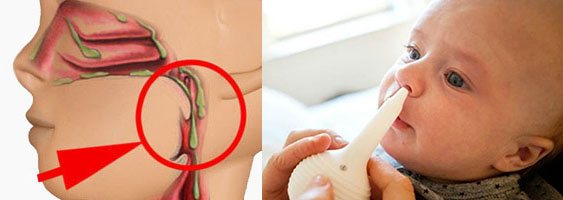
In a newborn, ARVI symptoms continue for up to 14 days
The incubation period is influenced by several factors. The presence of infectious agents can aggravate the situation. These microorganisms have a number of characteristics and negatively affect the overall well-being of the baby.
With the parainfluenza virus, the risk of developing laryngeal stenosis increases in a child. If the situation is not stopped in time, bronchitis can become chronic. The disease is dangerous if it begins to develop from an early age. Additionally, with pathology, the child develops snot and an increase in body temperature. Analysis of the clinical picture does not always show which virus or infection causes the disease to develop.
A baby without a fever will develop a cough and sniffles if they develop against the background of allergens entering the body. The symptom often appears in children during a holiday at sea or during a forced climate change.
Additional rules
To successfully combat cough and rhinitis, pediatricians advise following the following recommendations:
- Maintain the humidity in the baby’s room at a constant level, try to ventilate the room more often;
- The temperature in the child’s room should be no higher than twenty degrees;
- Follow proper nutrition – your baby should not be given spicy, fatty or hot food;
- Do not forget to maintain a drinking regime - a large amount of liquid promotes excessive urination, and the virus will leave the body along with the urine. Let your baby drink often, but little by little;
- If you have a cold, regularly rinse your child’s nose; this can be done with saline solution (sold at any pharmacy) or Aquamaris for children.
These measures, along with drug treatment, will help the baby cope with the disease and forget about the unpleasant symptoms of a cold.
Fever without cough and runny nose is an indicator of weakened immunity
Fever without a runny nose is an indicator of decreased immune function. When the thermometer shows 37.5 degrees Celsius, many parents rush to offer their baby an antipyretic. In fact, snot and a temperature of 37 are not a reason to panic. You need to understand how the immune system works.
The presence of temperature at the initial stage of a cold is an indicator that the body is ready to fight harmful bacteria. Only at a body temperature of 38 degrees Celsius do viruses and bacteria die or lose the ability to reproduce.
When a child has snot and fever, you need to be patient. As soon as the child sweats, he will immediately feel better. Of course, a high fever and runny nose are a good reason to offer your baby an antipyretic drug.
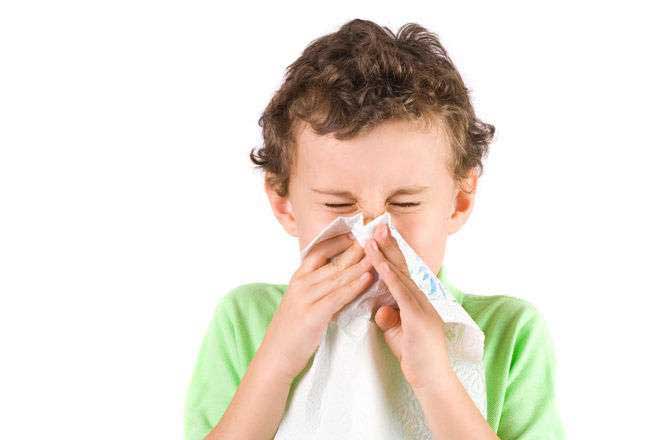
Syrup or tablets: what to choose
Fever and runny nose in a child of preschool and school age most often appear during a cold. Taking an antipyretic is allowed only when the thermometer shows 38 degrees or higher. An infectious disease can be different - rhinitis, sore throat, tonsillitis, sinusitis or influenza.
The doctor's prescription will contain an antipyretic drug. Fever can be reduced only with its help. Moms and dads need to know that antiviral and antibacterial medications do not reduce body temperature. Their action is aimed at destroying bacteria and viruses.
It remains to decide which drug to give preference to. In the pharmacy you can find syrups and tablets for fever without runny nose and snot. The choice directly depends on the age of the baby:
- 0-1 year – syrup (Nurofen). The medication is available in orange or strawberry flavors, so your little one won’t refuse to take it.%
- 1-5 years - syrups with or without flavoring, if the young patient has allergies;
- 5-14 years - tablets.
On this topic:
Treatment methods for cough in a child, causes, tips and recommendations
After purchasing the drug, you should pay attention to the instructions. If parents do not have the opportunity to buy syrup for a child under three years old, then they can use a tablet. But it is first crushed into powder and diluted with water in a teaspoon. The dosage is prescribed in the instructions.
Traditional methods of treatment
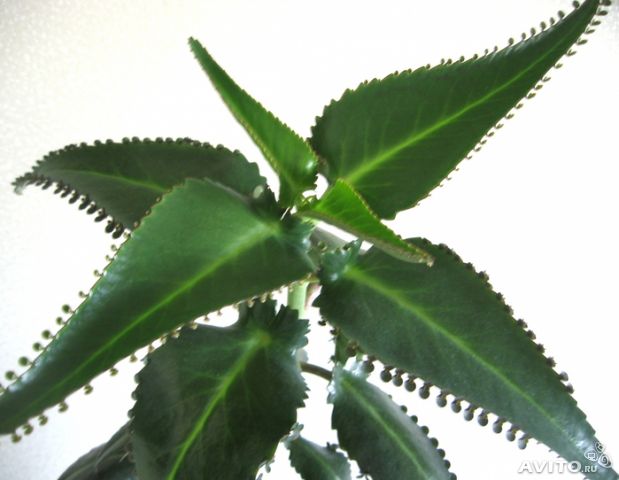
They are used as additional methods and only after the permission of the attending physician. This treatment is allowed for older children, since small children will not yet be able to complete all the procedures.
- If your baby coughs a lot, inhaling the vapors of boiled potatoes will help him. Boil the tuber, the child should breathe over it for 15 - 20 minutes, covering his head with a towel. But you should be careful not to bend close to the steam, so as not to burn the mucous membrane.
- A runny nose is treated with freshly squeezed aloe or Kalanchoe juice. Mix juice with water in a ratio of 1 to 10. Place in both nostrils. It cannot be used while using Sanorin and Naphthyzin. This can cause sinusitis.
- For wet coughs, inhalations through a nebulizer help. Baking soda and medicinal herbs are used as active substances. Regular inhalations will alleviate the unpleasant symptom.
Conclusion

A cough and runny nose can bother a child even without a high fever. Symptoms may be caused by viral infections or allergies to external irritants. If rhinitis and cough occur, you should consult a doctor. He will determine the cause of their occurrence, then prescribe treatment. Following all the pediatrician’s recommendations will allow the baby to recover quickly and forget about cough and runny nose.
Remember that only a doctor can make a correct diagnosis; do not self-medicate without consultation and diagnosis by a qualified doctor. Be healthy!
Dry cough
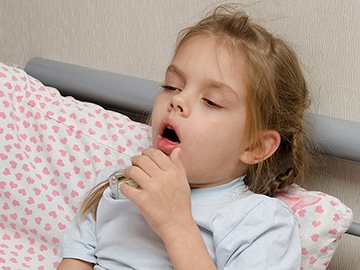
A cough that is not accompanied by mucus or sputum is called dry.
Unfortunately, attacks of such cough are painful and can be long-lasting.
The desire to cough is quite natural, as it allows you to clear the airways of microparticles of dust or excess phlegm, but if the cough becomes prolonged, repeats at night, does not bring relief and even ends with vomiting, you should consult a pediatrician.
The most common causes of dry cough in children are:
- entry of foreign small objects into the respiratory tract. For example, a small speck can cause a severe cough;
- chronic bronchitis, often the infection can be cured, but the cough remains for some time;
- allergic reactions to external irritants. In children, allergic reactions that take the form of cough can occur to plant pollen (during the flowering period), household chemicals and house dust. This in turn can lead to the development of asthma. Attacks appear after physical or psycho-emotional stress. Often attacks begin with a long and painful night cough. In this case, you must immediately consult a doctor and begin treatment;
- incipient gastrointestinal diseases. During the digestion of food, hydrochloric acid can enter the esophagus, which irritates its walls. Stagnation of hydrochloric acid leads to gastritis and often manifests itself in a dry cough;
- psycho-emotional stress. In children, after suffering stress, uncontrollable muscle spasms may occur, which is why the child may cough for some time. After the child calms down, the cough will stop on its own;
- beginning tuberculosis. This is the most serious manifestation of a dry cough. In addition to constant coughing, the child experiences lethargy, weakness, lack of appetite and general malaise. In this case, you cannot rely on fate and try to self-medicate. Complex conservative therapy in a hospital setting is required.
We must not forget about the danger of helminthiasis. In some cases, constant coughing may indicate infection with parasites, such as worms. It is recommended to get tested and undergo treatment if necessary.
Why might this occur?
A cough does not always indicate poor health . Pediatricians say that children cough up to 10 times a day only because microscopic dust particles get into the respiratory tract or lungs. This is how the body gets rid of foreign elements.
If the child does not lose his appetite, is not capricious and continues to play actively, there is nothing to worry about.
But sometimes the causes of cough in infants and older children without snot and fever can be various pathologies.
- Viral diseases. A cough without fever or runny nose is a symptom of an incipient viral disease. An infection that enters the respiratory system irritates the mucous membrane. The latter tries to get rid of the uninvited guest by secreting mucus. This mucus is coughed up by the child.
- Chronic respiratory diseases and consequences of whooping cough in children. Chronic tracheitis, bronchitis and pharyngitis provoke the periodic appearance of a wet cough. In this case, viscous, opaque sputum is expectorated.
- Dry indoor air.
Often in winter, when apartments are heated, children begin to suffer from a dry cough. Its cause is drying of the mucous membranes of the nose and throat. Inhalations will help get rid of it. - Allergy. A dry cough occurs when an allergen is near the baby: an animal, fluff, dust, a cleaning product. In this case, fever and runny nose may be absent.
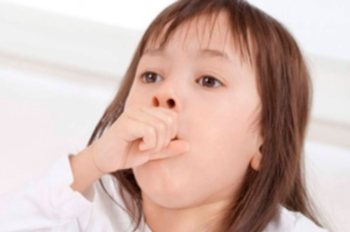
Parents should take their child to an allergist: he will conduct tests and find out what is causing the allergic reaction.
- Foreign body in the bronchi or lungs. Little children love to put peas, construction kits, and candies into their noses. Small objects get stuck in the nasal passage or respiratory tract, irritating the mucous membranes. This is why the baby has to constantly clear his throat.
- Cystic fibrosis. This is a congenital disease that affects the endocrine glands. Cystic fibrosis is accompanied by a severe cough, chest pain, and viscous sputum.
- Tuberculosis. In the initial stages, tuberculosis can occur without fever, so you should consult a doctor if your child has a constant dry cough.
- Periodic coughing may be a symptom of congenital heart disease. If your baby suffers from attacks of dry cough, during which he turns pale and experiences chest pain, you should consult a cardiologist.
- Worm infestation. Often a lingering dry cough indicates the presence of worms in the body. The cough worsens during periods of worm activity, occurring again and again every 2-4 weeks.
- Diseases of the digestive tract. If stomach contents back up into the esophagus or respiratory tract, the baby may experience a dry cough. At the same time, belching and heartburn appear.
- Nervous breakdown. Parents, intensely concerned about the physical health of the baby, often forget about his psychological comfort. A cough can occur as a result of stress or fear.

If a child is unbalanced by a change of environment, an unfavorable emotional atmosphere in the family, or entering a kindergarten or school, he may experience a dry cough. Parents need to take their child to a child psychologist.
A cough becomes a reason to see a doctor if:
- prevents you from falling asleep and wakes your baby up at night;
- manifests itself in the form of debilitating attacks;
- lasts for a long time;
- provokes vomiting;
- associated with signs of allergy.
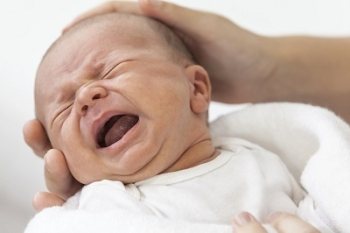
To make a diagnosis, the pediatrician will prescribe a comprehensive examination and advise you to visit an allergist, nutritionist, cardiologist, otolaryngologist, phthisiatrician, pulmonologist, gastroenterologist and child psychologist.
